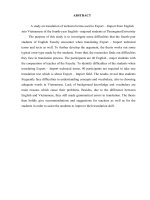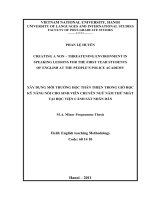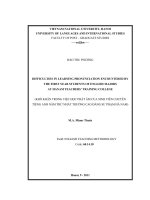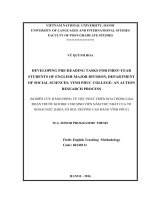Difficulties in learning pronunciation met by the first year students of English major at Hanam Teachers Training College = Khó khăn trong việc học phát âm của 20150227.PDF
Bạn đang xem bản rút gọn của tài liệu. Xem và tải ngay bản đầy đủ của tài liệu tại đây (1.07 MB, 51 trang )
iv
TABLE OF CONTENTS
Declaration…………………………………………………………………………….
i
Acknowledgements……………………………………………………………………
ii
Abstract…………………………………………………………………………
iii
Table of contents……………………………………………………………………
iv
List of charts and tables……………………………………… ……………………….
vi
PART I: INTRODUCTION……………………………… ………………………
1
1. Rationale of the Study………………………………… ……………………………
1
2. Aim of the Study…………………………………………………………………….
1
3. Research Questions…………………………………………….……………………
2
4. Methods of the Study…………………………………… ………………………….
2
5. Scope of the Study ……………………………………….…………………………
2
6. Significance of the Study………………………………… ………………………
2
PART II: DEVELOPMENT………………………………………………………….
3
Chapter 1: Literature Review ………………………………………………………
3
1.1. Place of Pronunciation in Communicative Competence and Foreign Language
Learning………………………………………………………………………………
3
1.2. Approaches to Pronunciation Teaching –Pronunciation Teaching
Methodologies …………………………………………………………………………
3
1.3. Factors Affecting Pronunciation Learning …………………………………………
5
1.4. Differences in the Sound Systems of the Two Languages: English and
Vietnamese .…………………………………………………………………………….
7
1.5. Some Common English Pronunciation Problems Met by Vietnamese
Learners .………………………………………………………………………………
8
Chapter 2: Methodology ……………………………………………………………
12
2.1. Context of the Study .………………….…………………………….……………
12
2.2. Participants of the Study …………………………………………………………
12
2.3. Instruments ………………………………………………………………………
13
2.3.1. Survey Questionnaire ……………………………………………………………
13
2.3.2. Interview ………………………………………………………………………
13
2.3.3. Classroom Observation …………………………………………………………
14
v
Chapter 3: Data Analysis and Discussions …………………….…………………….
15
3.1. Data Analysis and Discussions …………………………………………………….
15
3.1.1. Students’ Evaluation of the Importance of Pronunciation ………………………
15
3.1.2. Students’ Difficulties in Learning English Pronunciation ……………………
15
3.1.3. Students’ Difficulties with English Vowels ……………………………………
17
3.1.4. Students’ Difficulties with English Consonants ………………………………
18
3.1.5. Students’ Difficulties with Stress, Intonation and Rhythm ……………………
22
3.1.6. Causes of Difficulties in Learning English Pronunciation …………………
24
3.1.7. Teachers’ Suggestive Teaching Techniques …………………………………….
26
3.2. Summary of the Findings
26
Chapter 4: Recommendations ………………………………………………………
28
4.1. Amount of Exposure ………………………………………………………………
28
4.2. Attitudes and Motivation ………………………………………………………….
28
4.3. Suggested Teaching Techniques …………………………………………………
29
PART III: CONCLUSION ………………………………………………… ……….
37
1. Conclusions of the Study……………………………………………………………
37
2. Limitations of the Study……………………………………………………………
37
3. Suggestions for Further Study.……………………………………………… ……
37
REFERENCES …………………………………………………………………………
39
APPENDICES ……………………… ……………………………………………….
I-VII
vi
LIST OF CHARTS AND TABLES
Table1: Students’ evaluation of the importance of pronunciation
15
Table2: Students’ evaluation of the difficulties in learning English pronunciation
15
Table 3: Students’ evaluation of the difficulties in pronouncing long and short
vowels
17
Table 4: Students’ evaluation of the difficulties in pronouncing English consonants
19
Table 5: Students’ evaluation of the problematic positions of consonants in a word
19
Table 6: Students’ evaluation of the difficulties in pronouncing consonant clusters
20
Table 7: Students’ awareness of the concepts of stress, intonation and rhythm
22
Chart 1: Students’ evaluation of causes of the difficulties in learning pronunciation
24
1
PART I: INTRODUCTION
1. Rationale
English has become a language for global communication these days. In this common
trend, English in Vietnam has become one of the important, compulsory subjects at schools,
from primary school to high school system. No longer are students merely required to
master English grammar and vocabulary to sit for a test, they are now studying English to
develop their own communicative skills, of which intelligible pronunciation plays a crucial
part. With poor pronunciation, students have problems either making themselves
understood or understanding others. Therefore, there must be the appropriate concern on
teaching and learning pronunciation.
With the main purpose of training students majoring in English with high communicative
competence, the role of teaching and learning English pronunciation has been appreciated
right from the beginning of the course at Hanam Teachers‟ Training College. First-year
students majoring in English at the college have to complete the course titled “Practical
Pronunciation” with the course book “Ship or Sheep” by Ann Baker (1997). Nevertheless,
from the very first day of my teaching career in here, from my own observation and
experiences, I faced a fact that they had serious problems in pronunciation during the
pronunciation course even though each lesson was designed with clear, stated objectives. A
number of students mispronounced separated words and words combined in a sentence.
Others pronounced a sentence with equal stress, flat intonation and no rhythm at all.
Therefore, investigating the problems then look for some pedagogical suggestions to
improve the situation would be useful for the pronunciation learning and teaching at my
college. Last but not least, the issue has not caught much attention of our teaching staff and
there has not been any research on students‟ problems in learning pronunciation at Hanam
Teachers‟ Training College so far.
Being motivated by the situation, I would like to carry out a case study in order to figure
out the problems in learning English pronunciation met by the first year students at Hanam
Teachers‟ Training College. The research findings would be followed with suggestive
implications with the hope that the first year students at my college could do their best with
their English pronunciation.
2
2. Aims of the Study
This study is conducted with the following purposes:
- to investigate the first year students‟ perception on learning English pronunciation
- to find out what difficulties the first year students at Hanam Teachers‟ Training College
meet when they study English pronunciation
- to offer possible solutions to help students overcome their difficulties in learning English
pronunciation
3. Research Questions
In order to fulfill the above aims, the research is designed to seek answer to the two
following research questions:
1. What are the difficulties the first year students at Hanam Teachers‟ Training
College meet when they study English pronunciation?
2. What are the causes of the difficulties met by the first year students at Hanam
Teachers‟ Training College in their pronunciation learning process?
4. Method of the Study
This study is conducted as a case study which employs multi methods including qualitative
and quantitative methods. The former uses naturalistic observation, narrative diaries, and
collection of existing information while the later makes use of such instruments as
questionnaires and structured interviews.
5. Scope of the Study
The study focused on pronunciation learning of the first year students at Hanam Teachers‟
Training College with the course book “Ship or Sheep” by Ann Baker (1997).
6. Significance of the Study
Despite the fact that pronunciation plays an important role in learning a foreign language,
so far there have been few studies on the learning and teaching this language aspect
compared to other language skills such as speaking, listening, reading and writing. The
study looks for the first year students‟ difficulties in their learning English pronunciation,
following by pedagogical implications for the learning and teaching situation at Hanam
Teachers‟ Training College. Therefore, it contributes to enriching the researches on
teaching English pronunciation and to promote students in their learning afterwards. The
results of this study would be of much benefit to both teachers and students of English.
3
PART II: DEVELOPMENT
CHAPTER 1: LITERATURE REVIEW
1.1. Place of Pronunciation in Communicative Competence and in Foreign Language
Learning
Pronunciation plays a very important role in communicative competence since successful
communication cannot take place without correct pronunciation. (Celce-Murcia et al,
1996). Obviously, we may be proficient at grammar and have huge vocabulary, but we
pronounce words wrongly, we just cannot get ourselves understood in oral communication.
And even if we speak in an understandable way, still, we have to work on our
pronunciation. Poorly pronounced segments and suprasegments may have the result of
disorienting the listener and inhibiting comprehension.
Pronunciation is as important as any other aspects of foreign language learning like syntax
or vocabulary. Correct pronunciation is very necessary to develop speaking skill.
Pronunciation also has close connections to the other fields such as listening and even
grammar. Once a person can pronounce correctly the endings of the words, for example, he
can, at the same time give grammatical information. There is no doubt that incorrect
pronunciation tends to disrupt communication just as incorrect spellings do. (Sebastine,
2009)
In short, pronunciation has important values not only in oral communication but also in
foreign language learning. Acquiring good pronunciation is what a learner needs to make
effort to do on the way of mastering a foreign language.
1.2. Approaches to Pronunciation Teaching –Pronunciation Teaching Methodologies
The two general approaches to pronunciation teaching described in Celce-Murcia et al.
(1996) have been adopted by many researchers, which are intuitive-imitative approach and
analytical-linguistic approach.
An intuitive-imitative approach assumes that students can develop acceptable
pronunciation and speaking skills when exposed to the target language through accurate
models. This approach relies heavily upon imitation and repetition, without any explicit
information provided by teachers.
4
- The Direct method, which gained acceptance in the late 1800s and 1900s, was
formed from observations of children attaining their first language. In this method,
students would listen and imitate a model of the target language that was spoken by
the teacher (and later by recordings). (Celce-Murcia et al, 1996). However, students
who showed accuracy in controlled practice might fail to transfer what they
learned to actual communicative language use. (Cohen, Larson-Freeman, &
Tarone, 1991)
- From the late 1960s and the early 1980s, there was a decline in explicit
pronunciation teaching with the invention of the language lab. The Total Physical
Response by Ashers‟s (1977) and Natural Approach by Krashen and Terrell‟s (1983)
were among the most popular in the pronunciation training. In Total Physical
Response, students would begin to speak when they were ready and they were
expected to make errors in the initial stage. The main initial focus of Natural
Approach was listening, which gave students the opportunities to internalize the
target sound system. Indeed, many contemporary researchers still adopt this view but
it still needs further investigating if the method has the persuasive foundation.
An analytical-linguistic approach recognized the importance of explicit intervention of
pronunciation pedagogy in language acquisition. The approach employs a variety of
pedagogical aids including phonetic chart, contrastive exercises and articulatory
descriptions. In this approach, students are given explicit information about how to
produce the sounds and rhythms of the target language.
- The 1940s and 1950s witnessed a noticeable movement emphasized on explicit
instruction of phonetics with Audiolinguisim in the United States and the Oral
approach in Britain. Also relying on the recording or the teacher to model the target
language followed by the students‟ repetition of that language; however, teachers
also drew from their knowledge of phonetics and for the first time used simplified
charts of the IPA and articulatory models in the classroom. The Audiolinguism relied
much on drilling sound contrasts and minimal pairs with very little attention to
intonation and conversational speech. The techniques of minimal pairs drill were
used extensively by Baker (1997) in her very popular course book on contrastive
segmental instruction “Ship or Sheep.”
5
- The 1980s witnessed the significant shift with discourse based communicative
approach with the ultimate goal was communication. Under this trend,
pronunciation teaching focused more on a “top-down” approach instead of the
original “bottom up” method of teaching isolated sounds. In other words, the
focus of teaching pronunciation seemed to shift from mastery of segmentals (e.g.
vowels and consonants) to fluency, highlighting the importance of elements of
suprasegmentals (Pennington, & Richards, 1986). Techniques used to teach
pronunciation included listening and imitating, phonetic training, minimal pairs
drilling in context, visual aids, reading aloud, recording the students‟ production with
more focus on suprasegmental aspects of pronunciation. It can be seen that
communicative approach seems to be more balanced approach with the focus on both
accuracy and fluency. The approach had characteristics of both intuitive-imitative
approach and analytical-linguistic approach.
In the light of communicative language teaching (CLT), learners are expected to achieve
“intelligible pronunciation” of the target language, which is, according to Kenworthy,
(1987), understood by a listener at a given time in a given situation. That is, students are
able to understand, accept and declare to be recognized meaningfully in their oral
communication.
To sum up, trends of teaching pronunciation have been changing a lot during different
periods. Nowadays, teaching pronunciation plays a very important part in the language
teaching. It is the main target connected with other skills to get the highest purpose of
learning a foreign language, which is communication.
1.3. Factors Affecting Pronunciation Learning
There are many factors affecting the learners' pronunciation. According to Kenworthy
(1987:4-9), factors such as the native language, the age, amount of exposure, phonetic
ability, attitude and identity, motivation and concern for good pronunciation have great
influence on pronunciation learning.
1.3.1 The Native Language
The native language plays an important role in learning to pronounce English as it is
clearly seen that a foreign accent is influenced by some of the sound characteristics of the
6
learner's native language. Due to the role of native language, there has been a great deal of
research on the differences between sound systems of English and other languages in terms
of sound system as well as problems, difficulties the learners face when studying English.
According to Kenworthy, (1992: 4): "To put it very crudely, the more differences there are,
the more difficulties the learners will have in pronouncing English.”.
1.3.2 The Age
It is commonly assumed that people can pronounce a foreign language like a native if they
start learning it as a child. This leads to a question that whether there is an age-related limit
on the mastery of pronunciation.
1.3.3. Amount of Exposure
Another factor is the amount of exposure to English the learner receives. However, it does
not totally mean learners who have more opportunities speaking and listening with the
native English speakers can have better English pronunciation. Based on some recent
studies, it seems that amount of exposure is not a necessary factor but a contributory factor
for the development of pronunciation skills.
1.3.4. Phonetic Ability
Researchers demonstrate that some people are able to mimic sounds more accurately than
others. These abilities are innate, so this factor seems to be out of the teacher's control.
What the teacher can do is to investigate the abilities of the learners and provide a variety
of tasks so that something will suit the needs and ability of each learner.
1.3.5. Attitudes and Identity
It has been claimed that factors such as a person‟s „sense of identity‟ and feelings of „group
affiliation‟ are strong determiners of the acquisition of accurate pronunciation of a foreign
language. In many studies of attitude and motivation in language learning, it has been
shown that those learners who show positive feelings towards the speakers of the new
language tend to develop more accurate, native-like accents.
1.3.6. Motivation and Concern for Good Pronunciation
It cannot be denied that motivation is an important factor that determines the people's
participation in every activity especially in language learning. Motivation makes people
7
more active in learning. The more motivated the people are, the greater the cognitive
process is. Celce Murcia, Brinton, & Goodwin (1996) considered that motivation and
concern for good pronunciation affect pronunciation accuracy.
1.4. Differences in the Sound Systems of the Two Languages: English and Vietnamese
There are a number of books discussing this matter. In this study, the detailed comparison
of Vietnamese and English pronunciation by Doan Thien Thuat (2003), Nguyen Thien
Giap (1997), Ha Cam Tam (2005), O'Connor (1967), McNeil (1987), Hinst and Cristo,
(1998) has been adopted. The main differences between English and Vietnamese
pronunciation are presented hereafter:
1.4.1 Phonemes
In Vietnamese, a letter is often represented by the same phoneme (except /r/, /ng, ngh/, /k/
(c, k). While in English, the same letter may represent different sounds.
Besides, many words contain silent letters which may be at any positions in the word. This
feature is quite a challenge for Vietnamese students in learning pronunciation.
1.4.2. Vowels
Three out of seven short English vowels are absent in Vietnamese. Vietnamese does not
have vowel contrasts (minimal pairs) which means there is not discrimination between the
short and long. This is really a matter to Vietnamese students because they cannot
pronounce some words correctly without looking at its pronunciation transcription in the
dictionary.
1.4.3. Consonants
English has 24 consonants but there are only 22 in Vietnamese. There are some phonemes
in English but not in Vietnamese and vice versa. In Vietnamese, a letter is often
represented by the same phoneme. In English, some phonemes seem to be represented by
identical letters but different pronunciation. Vietnamese in general is spoken with a
staccato delivery. Syllables and words are not linked together as in English but are clearly
separated from each other. Especially final consonant clusters cause the greatest difficulties
for Vietnamese students.
8
1.4.4. Stress
Vietnamese is a basically monosyllabic language. Unlike English - a polysyllabic language,
most Vietnamese words have only one syllable. And unstressed syllable do not occur in
Vietnamese. Even in compound nouns, each syllable has its own distinctive tone. This is
the reason why stress within words does not exist in Vietnamese.
1.4.5. Intonation
There are six tones in Vietnamese: level tone, falling lone (grave), rising tone (acute),
broken tone (till), dot, and low-rising. These ones are lexical; they change the meaning of
words, just as changing one of the segmental phonemes (consonants and vowels) in
English can change the meaning of a word.
In English, on the other hand, intonation plays a much greater part. A statement can be
made into question by using intonation without changing the word order, which is not
possible in Vietnamese.
That is the reason why Vietnamese learners, while studying English, do not pay much
attention to learning English intonation, as they are not aware of the importance of using
correct intonation.
In conclusion, Vietnamese and English sound systems are different. A teacher of English
should take all these differences into consideration in order to make the learning and the
teaching process more effective. Basing on these components of pronunciation, moreover,
the first year students‟ difficulties in learning English pronunciation would be discussed in
details.
1.5. Common English Pronunciation Problems Encountered by Vietnamese Learners
For most Vietnamese learners, learning English pronunciation is of great challenge.
As being mentioned above, great differences between the sound systems of English and
Vietnamese cause a number of problems to Vietnamese speakers when they study English
pronunciation. Vietnamese is a tone language, that is, pitch changes distinguish word
meaning. Most words in Vietnamese consist of only one syllable, there are fewer
consonants than in English and there is no consonant cluster. That is why they often meet
some main problems when producing English as followed:









